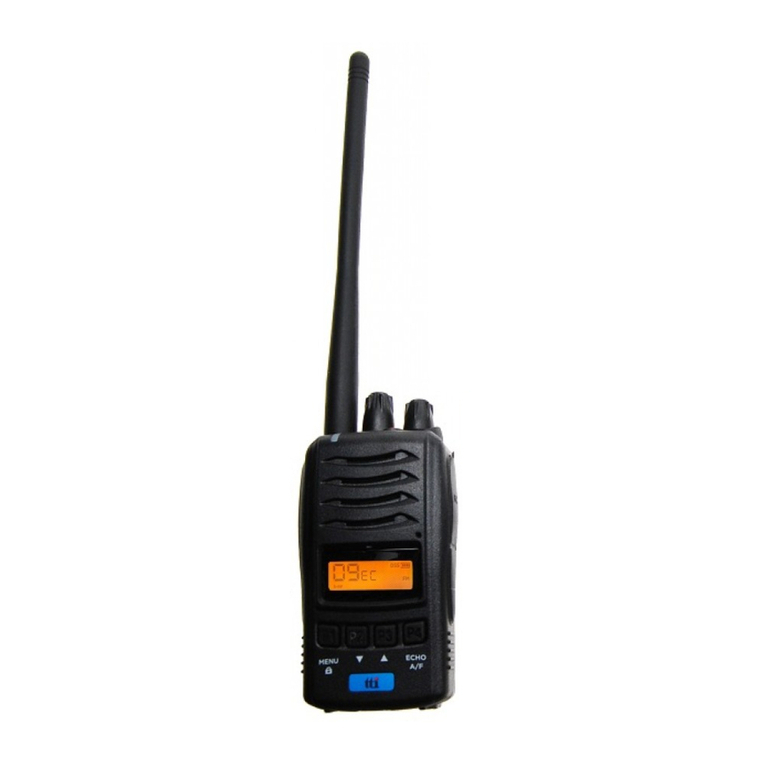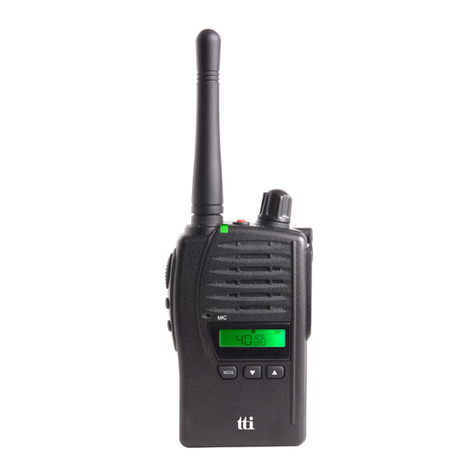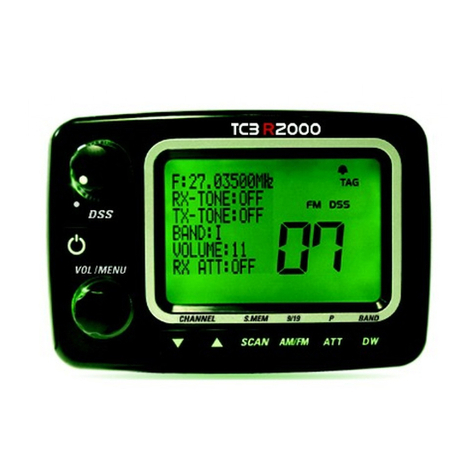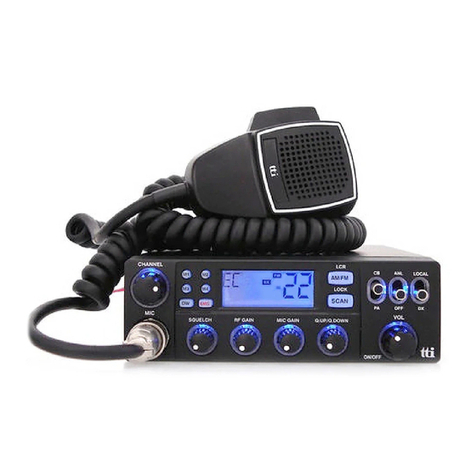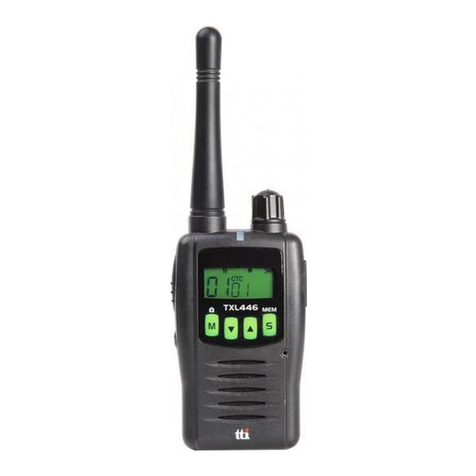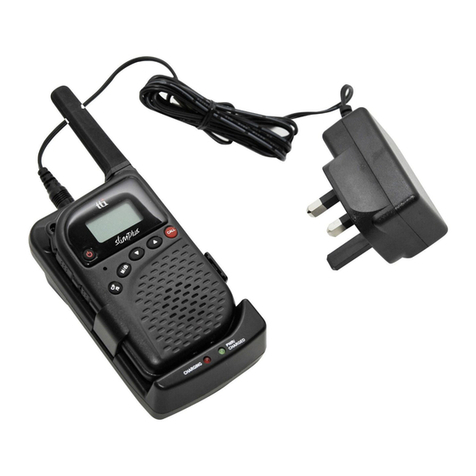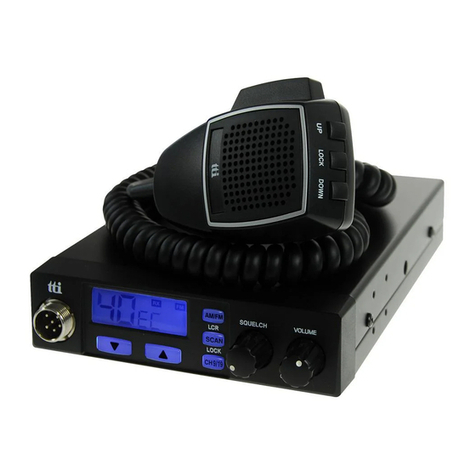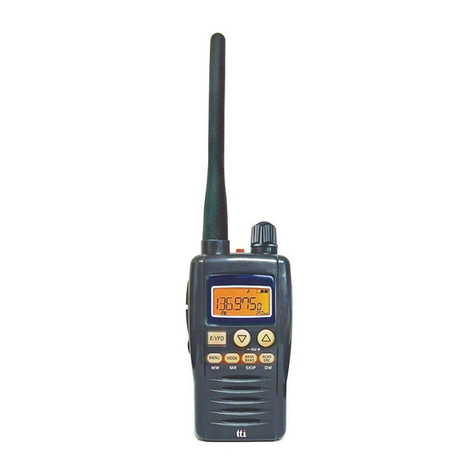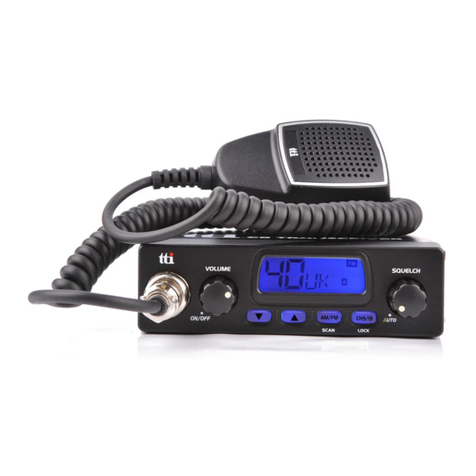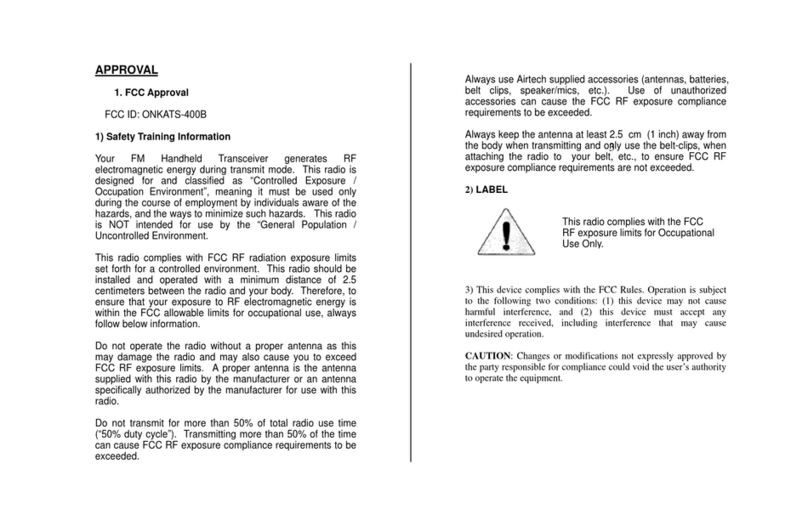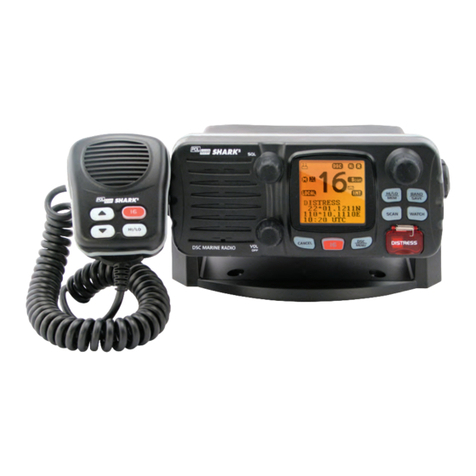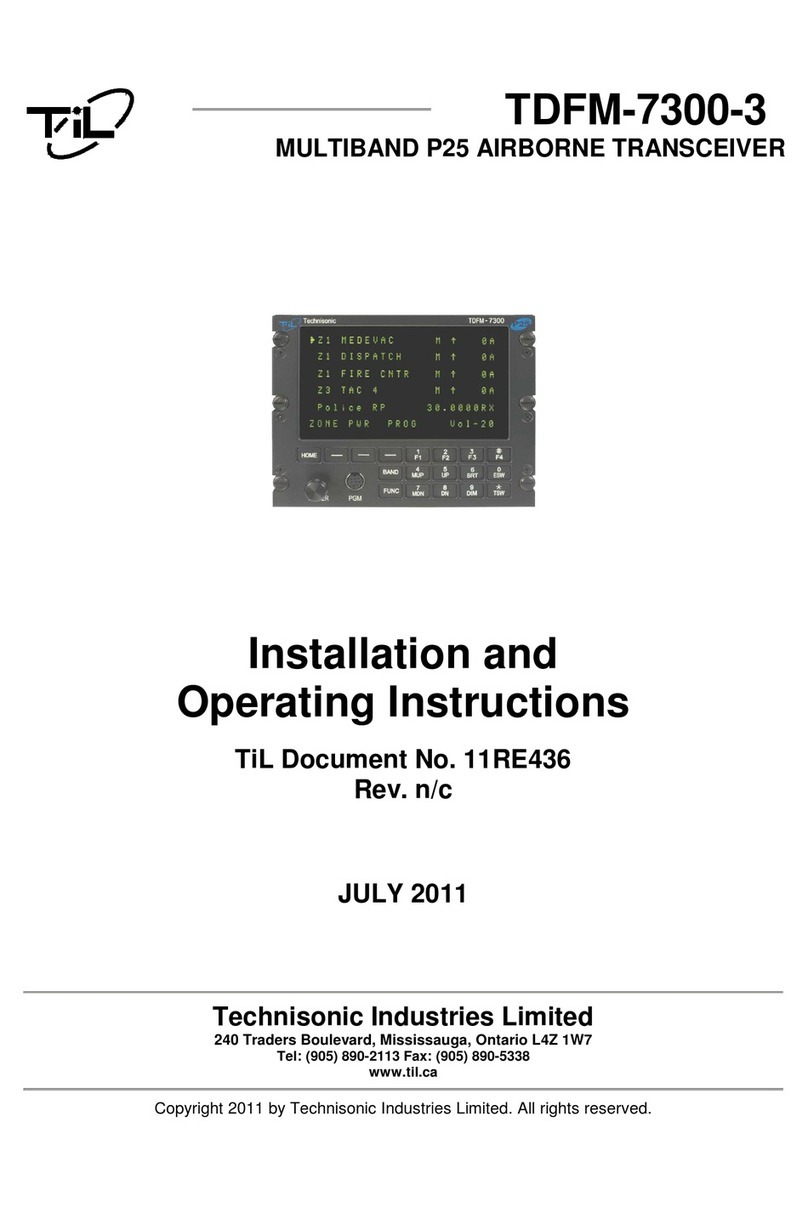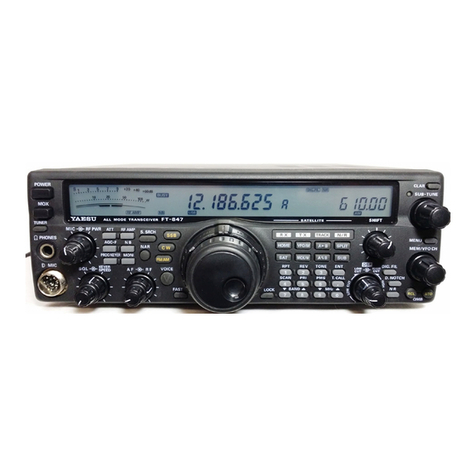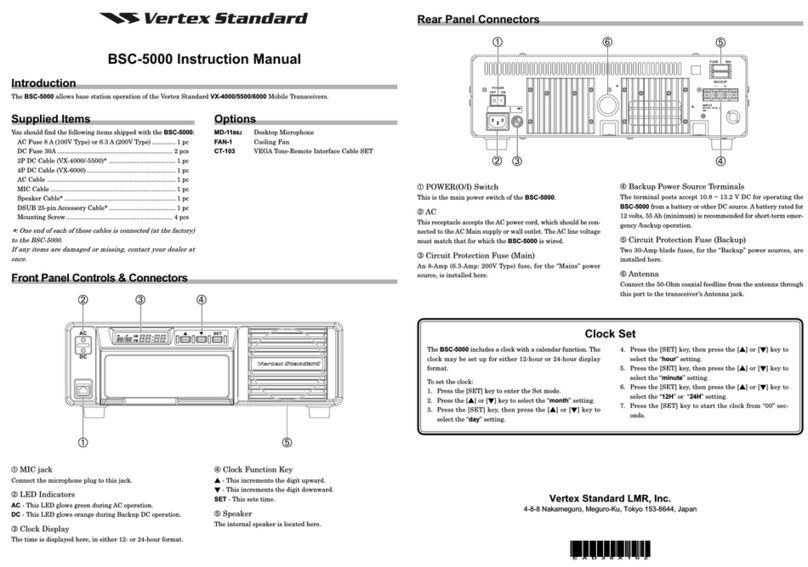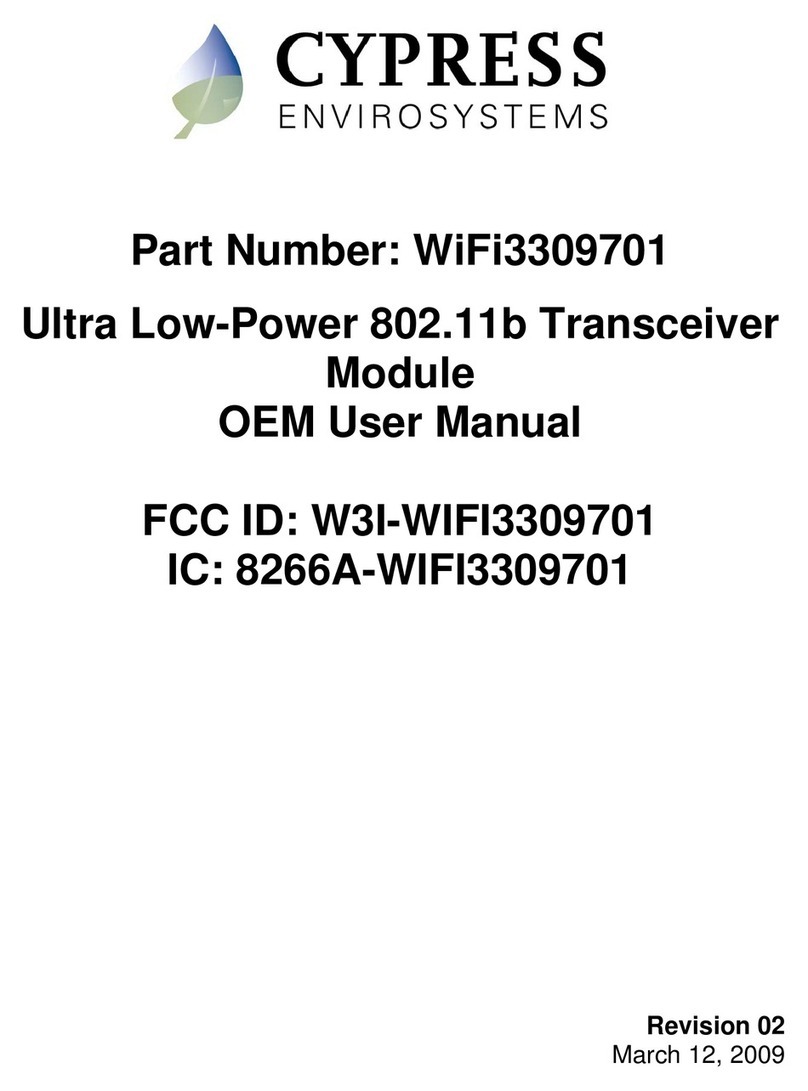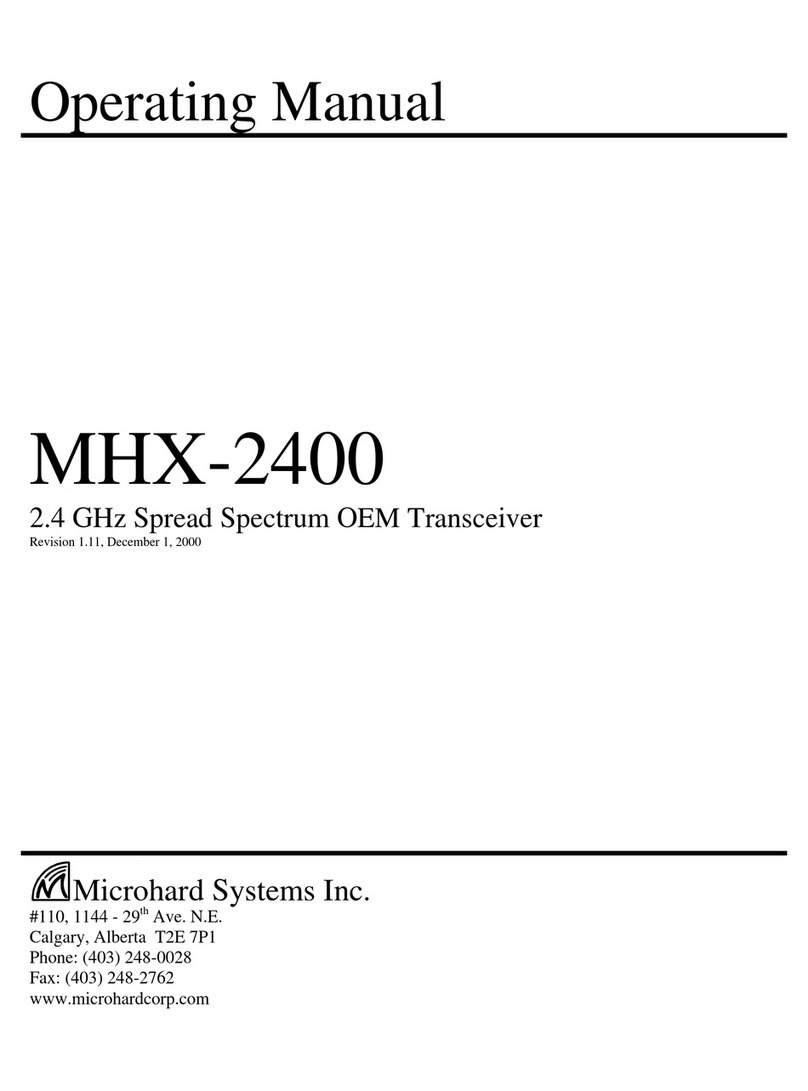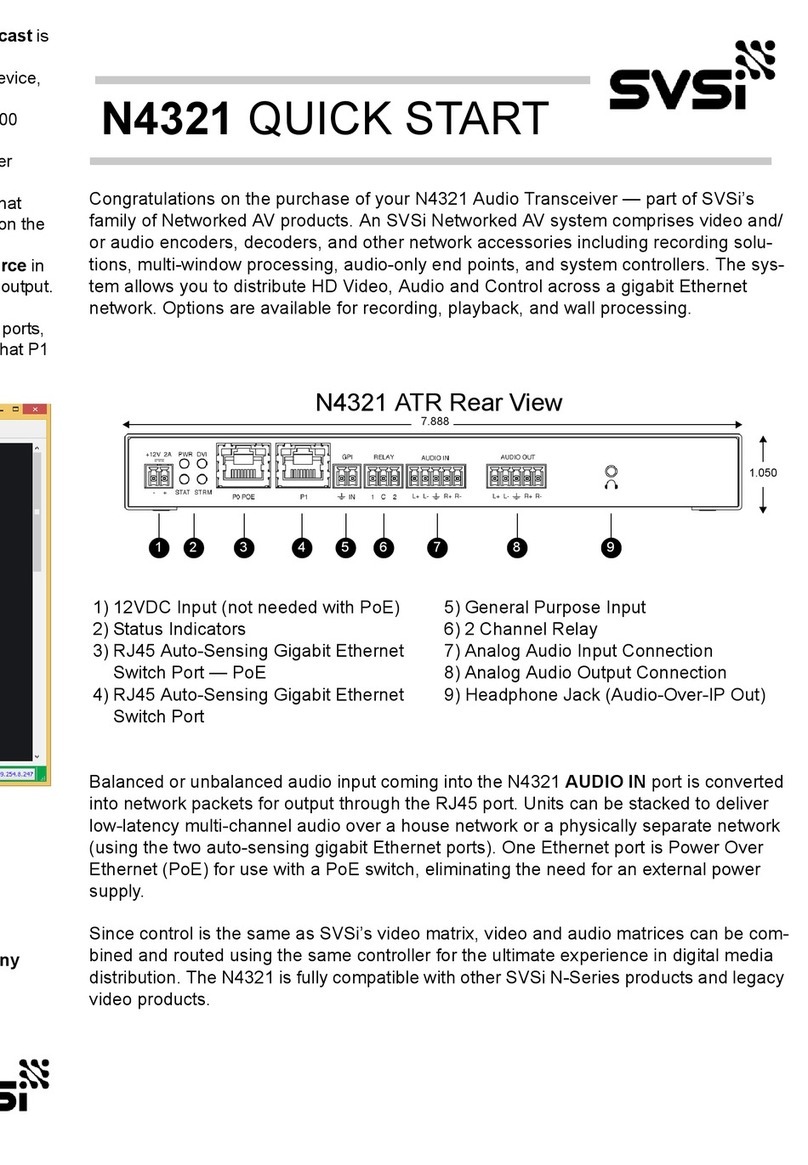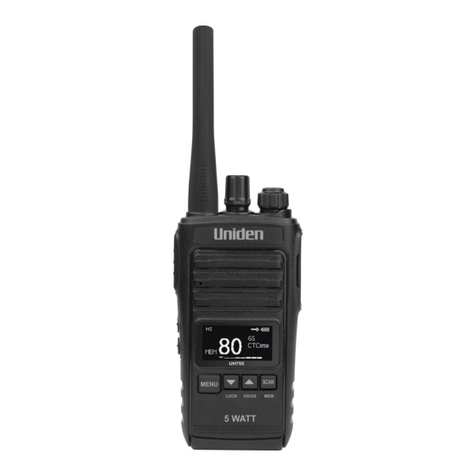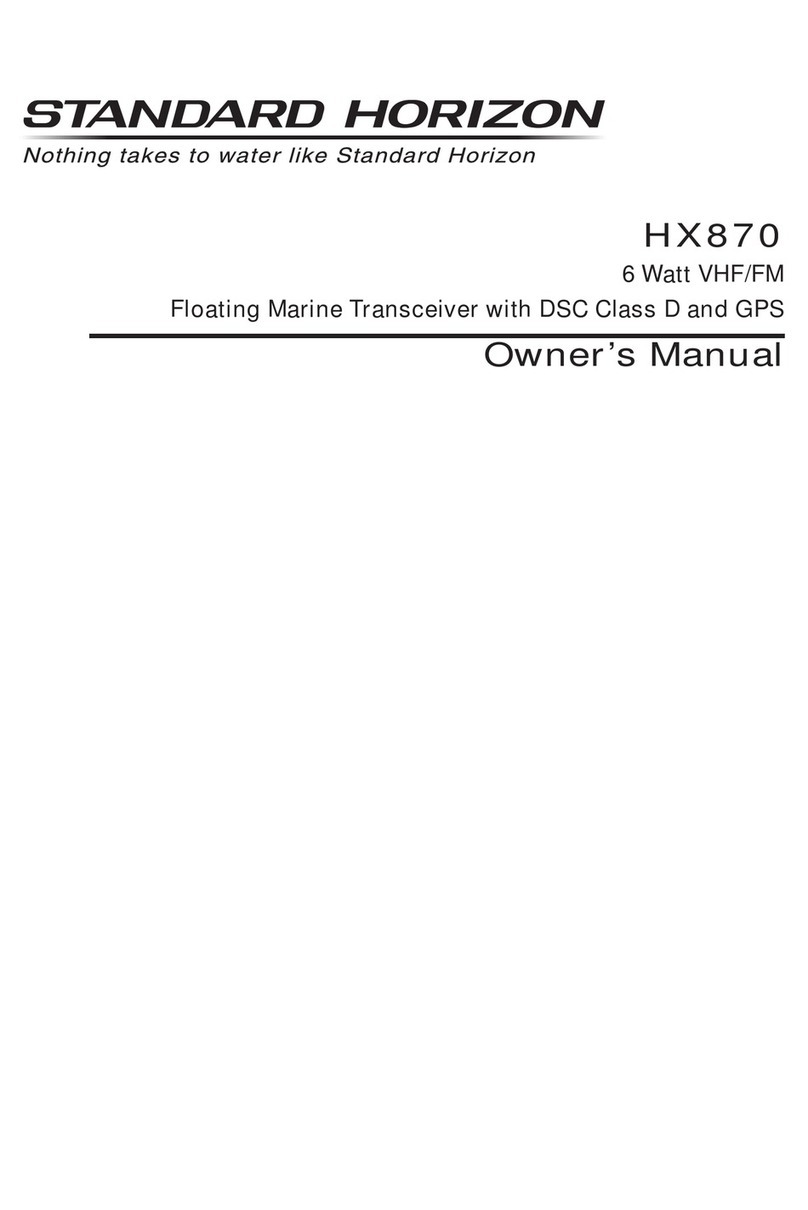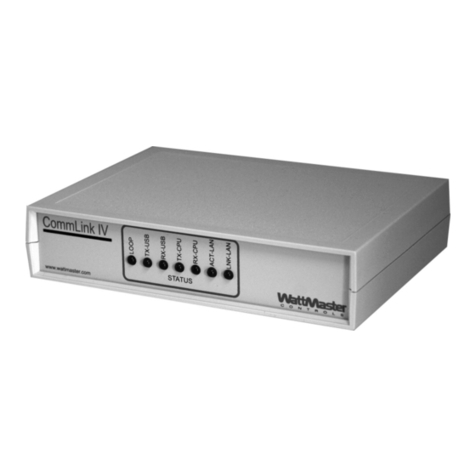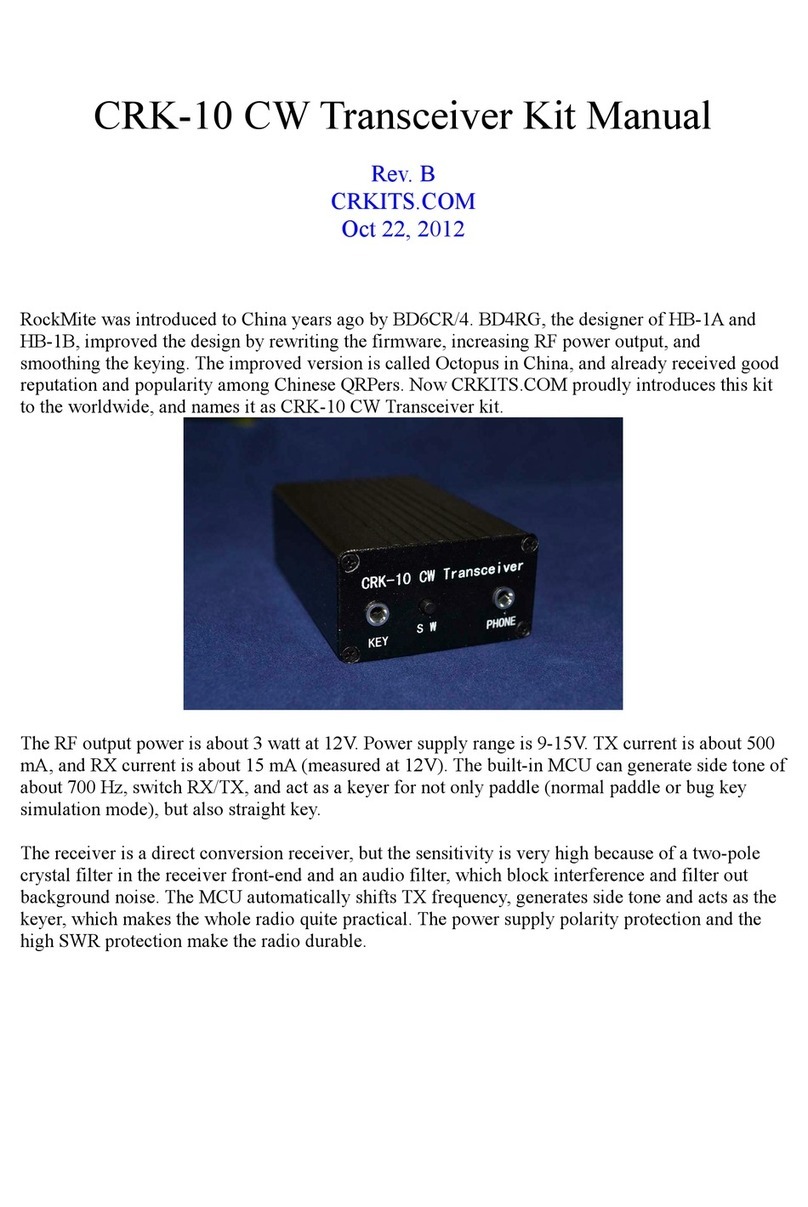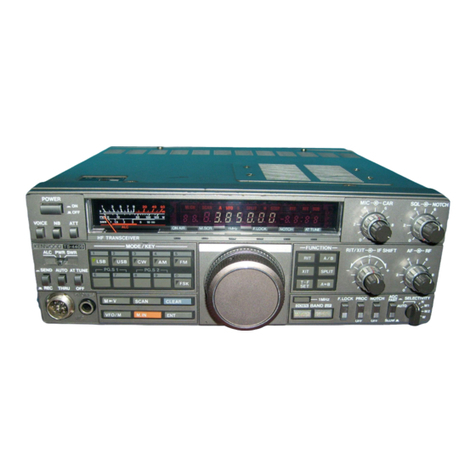TTI TCB-550 User manual

SERVICE
MANUAL
MULTI CHANNEL AM/FM TRANSCEIVER
TCB-550
TTI Tech
Downloaded from www.cbradio.nl

SECTION 1 SPECIFICATIONS
SECTION 2 CIRCUIT DESCRIPTION
1 GENERAL
2 TECHNICAL DESCRIPTION
3 SEMICONDUCTORS AND FUNCTION
4 DESCRIPTION OF FREQUENCY DETERMINING AND STABILIZING CIRCUIT
5 TEST EQUIPMENT SETUP AND ALIGNMENT INSTRUCTIONS
SECTION
5-3 LED PCB
3 PART LIST
SECTION
5-1 MAIN PCB
5-2
5-4 VOLUME PCB
5-5 MIC PCB
FRONT PCB
4 MECHANICAL DISASSEMBLY
SECTION 5 BOARD LAYOUT
SECTION 6 BLOCK DIAGRAM
SECTION 7 SCHEMATIC
TABLE OF CONTENTS

SECTION1 SPECIFICATIONS
Channel
Frequency Range
Operating mode
Frequency Control
Frequency Tolerance
Operating Temperature Range
Microphone
Input Voltage
Size
Weight
Antenna Connector
Power Output
Modulation
Frequency Response
Output Impedance
Harmonic Suppression
Current Drain
Receiving System
IF Frequencies
Sensitivity
Audio Output Power
Audio Distortion
Image Rejection
Adjacent Channel Rejection
Conducted Spurious
Frequency Response
Built-in Speaker
Squelch
* Specification is subject to change without prior notice.
T
R
A
N
S
M
I
T
T
E
R
R
E
C
E
I
V
E
R
G
E
N
E
R
A
L
40 (See the frequency band chart)
26.56 MHz ~ 28.00 MHz
F3E (FM), A3E (AM)
PLL Synthersizer
0.002%
-10 to + 55 C
Plug-in Type
13.2V DC ± 15%
124 (W) x 135 (L) x 37 (H)
655 g
Antenna Connector
Duty cycle 10% 4 Watts @13.2V DC
AM:from 85% to 95%
FM:1.8KHz ± 0.2KHz
300Hz to 3000Hz
50ohms, Unbalanced
More than -36dBm
AM Full Mod. 1.6A Max.
Dual conversion superheterodyne
Double Conversion 1st 10.695MHz/2nd 455KHz
0.7 V for 10dB(S+N)/N
in AM Mode
0.5 V for 20dB SINAD in FM Mode
2.0W @ 8 Ohm
Less then 8% @ 1KHz
60 dB
60 dB
More than 60 dB
300 to 2500Hz
8 Ohms, round
Adjustable; Threshold less than 1 microvolt

------------ Contents -------------
1General
1-1. Receiver
1.2. Transmitter
2. Technical Description
2-1. General
2-2. Type of emission
2-3. Frequency Table
2-4. RF Power Output
2-5. DC input Voltage and Current with 13.2V DC Input to Power AMP
2-6. Receiver IF and Local Oscillator Frequencies
3. Semiconductors and Function
4. Description of Frequency Determining and Stabilizing Circuit
4-1. Introduction
4-2. Basic Synthesis Scheme
4-3. Descriptions of Each Block
4-3-1. Introduction
4-3-2. Reference Frequency
4-3-3. VCO
4-3-4. Programmable Divider and its Control
4-3-5 Phase Detector and VCO Control
4-3-6. Transmitter / Receiver Buffer AMP
4-3-7. Transmitter Doublers
4-3-8. Switching of Turning Capacitor in VCO
4-3-9. Receiver Local Oscillator Outputs
4-4. Frequency Stability
4-5. Description of other Circuits
4-5-1. Transmitter
4-5-2. Receiver
5. Test Equipm
VCO Section
Transmitter Section
Receiver Section
Test Data
Schematic Diagram
Block Diagram
PCB Map
PARTS LIST
ent Setup and Alignment Instructions
5-1.
5-2.
5-3.
6.
7.
8.
9.
10.
SECTION2 CIRCUIT DESCRIPTION

1. General
1-1. Receiver
Display : 40 Channels and other functions indication
Frequency Range : 26.965 to 27.405 [MHz]
Frequency Response : 300 to 2,500 [Hz]
Power Source : 13.2 [V] DC
Audio Output Load : 8 [OHM] Resistive
Audio Output : 4.0 [W] (or More)
Squelch : Adjustable from 0.2[uV] to 1 [mV]
Sensitivity :
-FM : 20 dB [SINAD] under 1.0 [uV] or less
-AM :10 dB [S/N] under 1.0 [uV] or less
Intermediate Frequency :
-1st IF : 10.695 [MHz]
-2nd IF : 455 [KHz]
1-2. Transmitter
Carrier Power(Conducted) : AM 1 [W] / FM 4.0 [W]
Current Drain ( 13.2 [V] Supply Voltage)
-No Modulation : 1,100 [mA] (No Modulation)
-Max Modulation : 1,400 [mA] (Full Modulation)
Modulation Capabilities
-AM : +/- 90 [%]
-FM : +/- 1.8 [KHz/Dev]
Spurious Radiation : Less then -74 [dBc]
Antenna Impedance : 50 [OHM]
Frequency Tolerance : 0.002 [%]

2. Technical Description
2-1. General
Model CB-550 is an mobile type AM/FM radio transceiver for use of the Citizen Radio Service.
Front Panel Controls
LCD Display(Cannel ,RX,TX,AQ,SCAN,AM,FM,EMG Indicator).
Receiver Audio Control (With Power ON/OFF Control) Volume
Squelch Control Volume (S/W ON : TIGHT, S/W OFF : AUTO SQ)
RF Gain Control Volume
CHANNEL UP/DOWN TACT SWITCH.
AM/FM TACT SWITCH
EMG TACT SWITCH
Accessable Connectors
Antenna Jack
External Speaker Jack
External Power Cord
Microphone Jack.
Transmitter Power AMP ----------- VOLTAGE 12.5 V
Current 820mA
Transmitter DRIVER AMP --------VOLTAGE 12.5 V
Current 130mA
2-2. Type of em
2-3. Frequency Range : 26.965 MHz (CH.1) - 27.405 MHz (CH.40)
2-4. RF Power Output : AM/FM 4.0 Watts
2-5. DC Input Voltage and Current With 13.2V DC Input to Power AMP
FIRST IF -------------------------------- 10.695 MHz
SECOND IF ---------------------------- 455 KHz
FIRST LOCAL OSCILLATOR------- 10.965 MHz Below RECEIVING FREQUENCY
SECOND LOCAL OSCILLATOR--- 10.240 MHz
2-6. RECEIVER IF AND LOCAL OSCILLATOR FREQUENCIES.
ission : AM(A3E) , FM(F3E)

2-3. SEMICONDUCTORS AND FUNCTION
REF.NO
*** MANUFACTURER INFORMATION ***
* K.E.C --------------- KOREA ELECTRONICS SEMICONDUCTOR CO.,LTD.
* TOSHIBA -------------- TOSHIBA SEMICONDUCTOR CO.,LTD.
* SANYO ---------------- JAPAN SANYO SEMICONDUCTOR CO.,LTD.
* SGS --------------------- SGS THOMSON SEMICONDUCTOR CO.,LTD.
DESCRIPTION RX TX REMARK
QR1
QR2
QR3
QR4
QR5
QR6
QR7
QQ1
QQ2
QQ4
QAS1
QAS2
QAS3
QAS4
QFS1
QFS2
QUS1
QRS1
QTS1
QG1
QG2
QG3
QG4
QG5
QHL1
QV1
QW1
QW2
QN1
QN2
QT2
QT3
QT4
Q1
Q2
Q3
IC1
IC2
IC3
IC4
IC5
IC6
IC7
KTC4080E
KTC4080E
KTC4080E
KTC4075E
KTC4080E
KTC4080E
KRA2014E
KRC410E
KTC4075E
KRC402E
KRC410E
KRA305E
KRC402E
KRC410E
KRC402E
KRC410E
KRC404E
KTC4075E
KTA2014E
KTA1658
KTA2014E
KRC401E
KTC3875S
KTC3875S
KRC402E
KTC4080E
KTC4080E
KTC4080E
KRC401E
KRA305E
KTC4080
2SC2314
2SC2078
KRA226S
KRC401E
KRC404E
DBL5019
KIA358F
TDA2003
24WCO2J
TMP86FM29UG
LC7152
KIA358F
RF AMP
1'st MIXER
1'st MIXER
RF ATTENUATOR
IF AMP
IF AMP
A.N.L.
SQ MUTE
RF ARRENUATOR
AUTO SQ S/W
FM MUTE
AM B+
AM B+ CONTROL
X
X
POP MUTE
SQ CONTROL
RX B+
X
X
X
X
MAIN REGULATOR
CPU REGULATOR
X
VCO
X
X
X
X
X
X
X
LCD BACK LIT
LCD BACK LIT
CPU RESET
FM 1F
SQ CONTROL
X
EEPROM
CPU
PLL
X
X
X
X
RF ATTENUATOR
X
X
X
X
RF ATTENUATOR
X
X
X
X
AM AUDIO PATH
FM AUDIO S/W
X
X
X
TX B+
TX POWER REGULATOR
TX POWER REGULATOR
TX POWER REGULATOR
MAIN REGULATOR
CPU REGULATOR
POWER HI/LOW S/W
VCO
BUFFER
DOUBLER
TX ENABLE
TX ENABLE B+
BUFFER
DRIVER
POWER AMP
LCD BACK LIT
LCD BACK LIT
CPU RESET
X
X
TX AM AUDIO AMP
EEPROM
CPU
PLL
TX FM AUDIO AMP
KEC
KEC
KEC
KEC
KEC
KEC
KEC
KEC
KEC
KEC
KEC
KEC
KEC
KEC
KEC
KEC
KEC
KEC
KEC
KEC
KEC
KEC
KEC
KEC
KEC
KEC
KEC
KEC
KEC
KEC
KEC
SANYO
SANYO
KEC
KEC
KEC
AUK
KEC
SGS
HOLTEK
TOSHIBA
SANYO
KEC

4. Description of Frequency Determining and Stabilizing Circuitry
4-1. Introduction
The Frequencies for transmitter and receiver first local frequencies are all derived from a signal
10.695MHz cry
Phase lcoked loop.
stal and second local frequencies are derived from 10.240 MHz crystal by means of a
The first local oscillator frequencies are 16.270MHz(CH1) to 16.710MHz(CH40). The second local
frequency is fixed at 10.240MHz to generate second IF 455KHz.
Transmit, the VCO of the PLL operates 13.4825MHz(CH1) to 13.7025MHz(40CH). The VCO frequency
goes to the doublers circuit DW2, LT1, LT2 which doubles the frequency to generate 26.965MHz(CH1)
to 27.405MHz(40CH).
QV1
VCO
QW1
Doublers
13.4825MHz(CH1)
~
13.7025MHz(CH40)
26.965MHz(CH1)
~
27.405MHz(CH40)
To transmitter
The VCO operating frequency for the receiver is 16.27MHz(CH1) to 16.710MHz(CH40) as the
first local oscillator, injected through the buffer amplifier Q302 into the first FET balanced mixer QR2,3.
4-2. Basic Synthesis Scheme
The crystal frequency(10.24MHz) is divided by4069times to make 2.5KHz which is fed to one
side of the phase detector. The VCO output is divided by a programmable divider, and fed to other side of
the phase detector Pin 22, 23 of IC6.
The feedback loop is closed by passing the phase detector output through an active low pass filter and using
the output to control the VCO frequency through varicap diode DV1,2.
Under locked conditions, both of phase detector input signal must be identical at 2.5KHz.
The VCO frequency is then given by ;
Receiver : Fvco / N = 0.0025 [MHz] OR Fvco = 0.0025 X N [MHz]
Since “N” is an integer, the VCO frequency can be stepped up with 2.5 KHz increments.
By suitable choice of “N” the desired output frequency can be obtained.
Channel 1 Channel 40
N Fvco N Fvco
Transmit 5393
3254
13.4825
16.2700
5481
3342
13.7025
16.7100
Receiver
See the [Table 1]for other Channels
The VCO frequency goes to the doublers circuit, with doubles the incoming signals.
VCO Output Frequency Doublers Output Frequency

Transmit
---
---
---
Transmit
CH 1 , 13.4825 MHz
CH 40 , 13.7025 MHz
26.965 MHz
27.405 MHz
Since all frequencies are obtained from the crystal controlled PLL oscillator, all outputs are
coherent with the crystal oscillator frequency and matching the same percentage accuracy.

Program Data & Frequency[Table 1]
RX TX
Channel Frequency
[MHz] N Fvco N Fvco
1 26.965 3254 16.27
5393 13.4825
2 26.975 3256 16.28
5395 13.4875
3 26.985 3258 16.29
5397 13.4925
4 27.005 3262 16.31
5401 13.5025
5 27.015 3264 16.32
5403 13.5075
6 27.025 3266 16.33
5405 13.5125
7 27.035 3268 16.34
5407 13.5175
8 27.055 3272 16.36
5411 13.5275
9 27.065 3274 16.37
5413 13.5325
10 27.075 3276 16.38
5415 13.5375
11 27.085 3278 16.39
5417 13.5425
12 27.105 3282 16.41
5421 13.5525
13 27.115 3284 16.42
5423 13.5575
14 27.125 3286 16.43
5425 13.5625
15 27.135 3288 16.44
5427 13.5675
16 27.155 3292 16.46
5431 13.5775
17 27.165 3294 16.47
5433 13.5825
18 27.175 3296 16.48
5435 13.5875
19 27.185 3298 16.49
5437 13.5925
20 27.205 3302 16.51
5441 13.6025
21 27.215 3304 16.52
5443 13.6075
22 27.225 3306 16.53
5445 13.6125
23 27.255 3312 16.56
5451 13.6275
24 27.235 3308 16.54
5447 13.6175
25 27.245 3310 16.55
5449 13.6225
26 27.265 3314 16.57
5453 13.6325
27 27.275 3316 16.58
5455 13.6375
28 27.285 3318 16.59
5457 13.6425
29 27.295 3320 16.60
5459 13.6475
30 27.305 3322 16.61
5461 13.6525
31 27.315 3324 16.62
5463 13.6575
32 27.325 3326 16.63
5465 13.6625
33 27.335 3328 16.64
5467 13.6675
34 27.345 3330 16.65
5469 13.6725
35 27.355 3332 16.66
5471 13.6775
36 27.365 3334 16.67
5473 13.6825
37 27.375 3336 16.68
5475 13.6875
38 27.385 3338 16.69
5477 13.6925
39 27.395 3340 16.70
5479 13.6975
40 27.405 3342 16.71
5481 13.7025

4-3-1. Introduction
The synthesizer is implemented with the following companents :
IC6 is a CMOS LSI that includes most of PLL block. The VCO with varicap diode DV1,2 as
a part of the oscillator tank circuit.
QV2 is a switching transistor to connect or disconnect the tunning capacitor in the VCO oscillator
tank circuit for transmitter or receiver.
The crystal, X2(10.24MHz) and other components at PIN 1 and 24 of IC6 can make a reference
frequency oscillator with internal amplifier.
The oscillator output is internally fed to a divied by 4096 to produce A 2.5KHz swuare wave witch
is the reference input to the phase detector.
QV1 is connected as a hartley type oscillator with varicap diode as part of the tank circuit. With
Appropriate control voltage on D601 the VCO can be oscillate over the required range of
13.4825MHz to 16.710 MHz.
4-3. Description Of Each Block
4-3-2. Reference frequency
PLL IC (IC6)
X-TAL(X2)
VARICAP DIODE(DV1,2)
4-3-3. VCO
The programmable inputs for each channel are set by the PLL clock(PIN34), DATA(PIN35),
Enable(PIN33) of IC5.
Each input signal to control the PLL IC is done with the provided key input PIN 12~15.
For each key input, an internal code convert EEPROM provides the appropriate control to the
programmable divider for that channel.
Since the change transmit and receive, and additional BIT is required ar PIN 16 of IC5 to allow
the ROM to recognize the status TX or RX.
During transmit the push to talk switch grounds PIN 16 thru diode(DS1) which is the transmit
status.
Thr programmable divider output is fed to the phase detector for comparison with the 2.5KHz
reference. See TABLE 1 for actual input and divide ratio on all channels.
The phase detector is a digital phase comparator which compares the phase of the reference
woth programmable divider output square waves and develops a series of pulses whose DC
level depends on the phase error of each signal.
The phase detector pulse output is fed to an active low pass filter and RC LPF ouput signal
of IC6 is filtered and fed to varicap DV1,2 control the VCO frequency.
4-3-4. Programmable divider and its control
4-3-5. Phase Detector and VCO control

4-3-6. Transmitter / Receiver Buffer AMP
The VCO output is fed into buffer AMP QW1 from the capacitor of CW1.
4-3-7. Transmitter Doubler
The output signal of QW1 goes to an amplifier tuning circuit(27MHz) QW2, LT1, LT2 which
doubles incoming 13MHz signals.
4-3-8. Switching of tuning capacitor in VCO.
The VCO circuit must turn with a wide range of frequencies 13.4825MHz - 13.7025 MHz for
transmitter and 16.27MHz - 16.710 MHz for receiver. The use of one tuning capacitor in common
has adverse effects as a decrease in C in the tuning circuit and the occurrence of may spurious.
To eliminate these effects, the tuning capacitance is switched for transmission or reception.
The tank circuit consist of the primary of LV1, CV1, CV4, CV6, CV7 when receiving QV2 becomes
off.
So. the primary of LV1 and make tuning function. when transmitting, QW2 becomes on.
So, the primary if LV1 and the parable capacitance of CV11 make turning function.
4-3-9. Receiver Local Oscillator Outputs
4-4. Frequency Stability
-First Mixer :
The output of VCO is injected through buffer AMP QW1 and than
The emitter follower output through the emitter of 1'st mixer or 2,3.
-Second Mixer :
The output of 10.240 MHz oscillator circuit with X2 is injected into the if IC of IC1.
Incoming if signal and 10.240 MHz signal are mixed inside the IF IC to 2'nd IF signal 455MHz.
FM audio signal are recovered with the way of quadrature detector.
AM signlas are recovered with envelope detector.
LET : Fo=Crystal Oscillator Frequency
4-5. Description of other circuits.
4-5-1. Transmitter
1. RF Amplification
THEN : Fvco= N X Fr = N(Fo/1800)
From which it can be seen, the percentage error in Ft is the percentage error in Fo.
The stability of the crystal oscillator is determined primarily by the crystal itself and having lesser
deviation by the active and passive components of the oscillator. The choice of crystal and
components is such that the required frequency stability is maintained over the required voltage and
tempertature range.
Fr=Phase detector reference frequency
Fvco=VCO frequency
Ft=Transmit freqency
THEN : Fr=Fo/1800
And under locked confitions : Fr =Fvco / N
Where N is the programmable divider divide ratio.

The output of doubler AMP QW2 is fed through double tuning(27MHz) LT1 and LT2 to the base
of PRE AMP QT2. The output is then supplied through tuning circuit LT3 to RF driver AMP QT3.
The QT3 output is capacitance divided by tuning circuit CT10, CT12, LT4, CT13 and passed through
the base of final RF stage QT4. The QT4 output is supplied to the antenna through L-C tuning circuit
(CT21, CT22, LT11, CT26, LT12, CT27, CT28, LT14, CT30).
The tuning circuit between frequency synthersizer and final AMP QT4 and 4-stage " PI"
network CT21, CT22, LT11, CT26, LT12, CT27, CT28, LT14, CT30 in the QT4 output circuit serve
to suppress spurious radiation. This network serves to impedance match QT4 to the antenna and to
reduce spurious content to acceptable levels in the frequency synthersizer.
2. Circuit for suppression of spurious radiation
After finished all alignment, the constant voltage supply circuit limites the available power 4W or
slightly less. Corresponding three-TR control supply voltage of RF power amplifier. When power
low S/W function QHL1 changed the supply voltage. Tune all the trimming parts for max indication
of RF power meter and adjust VR3 to make 4W indication of RF power meter. After finished the above
adjustment check the RF power meter reading is changed 1W under ' Low" state.
The tuning is adjusted so that the actual power is from 3.6 to 3.9 watts.
There are no other additional controls for adjusting the TX output power.
3. Circuit for Limiting Power
- AM
The MIC input is fed to audio power amplifier IC3 which drives modulation transformer TM1.
The audio output at the secondary of TM1 is fed the modulating audui signals series with the B+
voltage to the collectors of driver QT3 and TX power AMP QT4 to modulate both these stages.
A portion of the modulating voltage is rectified with DM1 which controls QM2 and QM1 to attenuate
the MIC input to MIC AMP IC3.
The resulting feedback loop keeps the modulation from exceeding 100 percent inputs approximately
40dB greater than that requires to produce 50% modulation.
- FM
The MIC input is fed to MIC audio amplifier IC7 that drives modulation varicap diode DV1,2 in the
VOC circuit RV3 limits the incoming modulation audio levels to inhibit over modulation. While
reading the modulation factor on the modulation analyzing equipment, adjustment RV3 shall not exceed
2.0 KHz deviation.
4. Modulation
4-5-2. Receiver
CB receiver is dual conversion super-heterodyne type with the first IF 10.695MHz and the
second IF 455KHz.
Receiver is separated two blocks, 1’st IF section and 2’nd IF section. The PLL synthesizer
supplies 1’st
With the provided first local frequencies QR2,3 mixes the incoming signal to generate first IF signal.
Mixed signals were filteres with the CF1(10.695MHz) crystal filter and tuned circuits.
With the 10.24MHz signal,IC1 FM IF IC converts the incoming signals to generate second IF signal.
2'nd IF is filtered by a razor sharp seramic filter CF3 coulpled.
The 455KHz signals from the 2nd IF filter were amplified and limits inernally. After amplification
the signals fed to the quadrature detector loop LR5. Than could see the recovered sifnals PIN 9
of IC1.
local frequency 16.270MHz ~ 16.710MHz.

AM signals form the PIN 5 of IC1 were tapped with CR34 and amplified two-stage amplifier QR5,6 is a
a first 455KHz amplifier.
DR3 is a detector diode witch produce audio signal as well as negative DC voltage fir AGC action.
The negative voltage laso provides forward biasing to the mitter of ANL clipping TR QR7.
The biasing voltage has a time constant determined RR44 and CR54.
Therefore any sharp negative going pulse from DR3 will back bias QR7 and clipped.
The way to recover the AM information audio is envelope detector.
** Test Equipment Setup and Alignment Instructions
5-1. VCO voltage adjustment
5-1-1. Required Test Equipment
1) DC power supply : 13.8VDC / 3A
2) DC Voltmeter or Oscilloscope
3) RF attenuator (30dB)
5-1-2. Alignment Procedure
Step Test Item UUT setting Equipment setting Alignment
point Spec.
1
RX VCO voltage Channel: CH1
UUT: RX condition
Others: Don’t care
Measure the DC voltage
on the VCO test point LV1 1.8~2.1
Adjustment
(VDC)
2
TX VCO voltage Channel: CH1
UUT: TX condition
Others: Don’t care
Measure the DC voltage
on the VCO test point
LV1 1.5~2.5
Adjustment
(VDC)
5-3. Equipment connection
Figure 1

5-2. Transmitter Section Alignment
5-2-1. Required Test Equipment : If uses in HP8920, the 1)~7) equipment is not a necessity.
1) RF Power Meter
2) 50 ohm Load (non-inductive)
3) RF attenuator (30dB)
4) Audio Generator
5) Modulation meter
6) Frequency counter
7) DC Voltmeter
8) Spectrum analyzer
9) DC power supply: 13.8VDC / 3A
10) Oscilloscope
5-2-2. Alignment procedure
Step Test Item UUT setting Equipment setting Alignment
point Spec.
1
TX
Frequency
Channel: CH19
Function:
1) AM or FM mode
2) CB
Unit: TX condition
Adjustment
(MIC PTT on)
Others: Don’t care
Connect the equipment and
UUT as shown on Figure.2
CTX1 27.185MHz
+/-300Hz
2
TX
Power
Channel: CH19
Function:
1) AM or FM mode
Adjustment
DC power supply : 15.6V
Unit: TX condition
(MIC PTT on)
Others: Don’t care
Connect the equipment and
UUT as shown on Figure.3 Max.4W
LT1
LT2 ( If cannot
get a power
up to 4W,
adjust VR3)
3
AM Modulation Channel: CH19
Function:
1) AM mode
2) CB
Unit: TX condition
Adjustment
(PTT on)
Others: Don’t care
Connect the equipment and
UUT as shown on Figure.3
Audio generator
1) Set to 1KHz / 50mV
2) Input to MIC
Adjustment:
1) Adjust RVM1 to obtain
85% modulation
RVM1 Max : 90 %

Step Test Item UUT setting Equipment setting Alignment
point Spec.
4
FM
Deviation
Adjustment
Channel: CH19
Function:
1) FM mode
2) CB
Unit: TX condition
(PTT on)
Others: Don’t care
Connect the equipment and
UUT as shown on Figure.3
Audio generator
1) Set to 1KHz / 50mV
2) Input to MIC
Adjustment:
1) Adjust RV3 to obtain
1.8KHz deviation
RV3 1.8KHz
5
TX
Signal
Meter
of the UUT
Adjustment
Band Mode : F Band
Channel: CH19
Function:
1) FM mode
2) CB
Unit: TX condition
(PTT on)
Others: Don’t care
Connect the equipment and
UUT as shown on Figure.2
AM:1W , FM:4W
Adjustment:
1. AM mode : 1 W
2. FM mode : 4 W
Should
display
.AM mode :
1W
TX - Bar
.FM mode :
4W
TX - Bar
6
Half harmonic
of the UUT
Adjustment
Channel: CH19 Connect the equipment and
UUT as shown on Figure.4
Spectrum
1) Reference Level 35dB
2) Span 50KHz
Function:
1) AM mode
2) CB
Unit: TX condition
(PTT on)
Others: Don’t care
Adjustment:
1) Carrier Level (by spectrum)
Center Frequency : 27.185MHz
Spec : 33 ~ 35dBm
2) Half Harmonic (by spectrum)
Center Frequency : 39.5925MHz
Spec : < -100 dBm
LT1
LT2 < -100dBm
7
2nd Harmonic
of the UUT
Adjustment
Channel: CH19 Connect the equipment and
Function:
1) AM mode
UUT as shown on Figure.4
Spectrum
2) CB
1) Reference Level 35dB
2) Span 50KHz
Unit: TX condition LT11
(PTT on)
Adjustment:
LT12 < -86dBm
Others: Don’t care LT13
1) Carrier Level (by spectrum)
LT14
Center Frequency : 27.185MHz
Spec : 33 ~ 35dBm
2) 2nd Harmonic (by spectrum)
Center Frequency : 54.37 MHz
Spec : < -86 dBm

Figure 2
Figure 3
Notch filter 30dB ATT TCB550
Power
Supply
Spectrum
Figure 4
5-3. Receiver Section Alignment
5-3-1. Required Test Equipment : If uses in HP8920, the 1)~4) equipment is not a necessity.
1) Standard Signal Generator (SSG)
2) SINAD Meter
3) AC Level Meter
4) Distortion Meter
5) Oscilloscope
6) DC power supply (13.2V/3A)
7) 8 ohm Dummy Load
5-3-2. Alignment procedure
Step Test Item UUT setting Equipment setting Alignment
point Spec.
1
AM
Audio output
Adjustment
Channel: CH19 Connect the equipment and
Function:
1) AM mode 2) CB
Unit: RX condition
Volume: Optional
Squelch: Minimum
Others: Don’t care
UUT as shown on Figure.5
SSG setting:
1) Freq.: 27.185MHz
2) AF: 1KHz
3) RF level: -47dBm
4) Modulation: 30%
LR1
L1
L2
L3
LR2
LR3
LR4
Audio Level:
>5V at maximum
unit’s volume.
Distortion:
<5% at 2V audio
level (need unit’s
volume adj. to get
2V audio level)

Step Test Item UUT setting Equipment setting Alignment
point Spec.
2
RX sensitivity Same as step ”1” SSG setting:
1) RF level: -107dBm
2) Others: same as step ”1”
<-107dBM
at 10dB SINAD
(if not,align again)
3
FM
Audio output
Adjustment
Channel: CH19
Function:
1) FM mode 2) CB
Unit: RX condition
Volume: Optional
Squelch: Minimum
Others: Don’t care
Connect the equipment and
UUT as shown on Figure.5
SSG setting:
1) Freq.: 27.185MHz
2) AF: 1KHz
3) RF level: -47dBm
4) Modulation: 1.5KHz
LR5
Audio Level:
>5V at maximum
unit’s volume.
Distortion:
<5% at 2V audio
level (need unit’s
volume adj. to get
2V audio level)
4
RX sensitivity Same as step ”3” SSG setting:
1) RF level: -107dBm
2) Others: same as step ”3”
<-107dBm
at 20dB S/N
(if not,align again)
5
TIGHT
Squelch
Adjustment
Connect the equipment and
UUT as shown on Figure.5
SSG setting:
1) Freq.: 27.185MHz
2) AF: 1KHz
3) RF level: -47dBm
4) Modulation: 1.5KHz
Channel: CH19
Function:
1) FM mode
2) CB
Unit: RX condition
Volume: Don’t care
Squelch: Maximum
Others: Don’t care
RVQ1
Adjust until
audio signal
is appeared
on the scope.
Adjustment:
1. adjust RVQ1
Connect the equipment and
6
AUTO
Squelch
Adjustment
Channel: CH19
as shown on Figure.5
Function:
1) FM mode
2) CB SSG setting:
1) Freq.: 27.185MHz
Adjust until
2) AF: 1KHz
Unit: RX condition
audio signal
RVQ2
3) RF level: -107dBm
Volume: Don’t care
is appeared
4) Modulation: 1.5KHz
Squelch VR: OFF
on the scope.
Others: Don’t care Adjustment:
1. adjust the RVQ2
Figure 5

SECTION3 PART LIST
NO LEVEL P/N DESCRIPTION QTY
1 ASSY 5A0-5504-000 LCD PCB ASS′Y - TCB550 1.00
2 PART 102-331J-S00 FILM RES. 330OHM 0.5W +-5 ST 1.00
3 PART 102-471J-S00 FILM RES. 470OHM 0.5W +-5 ST 1.00
4 PART 142-100J-000 CHIP RES. 0603 10OHM +-5 PHILIPS 1.00
5 PART 142-102J-000 CHIP RES. 0603 1KOHM +-5 PHILIPS 1.00
6 PART 142-104J-000 CHIP RES. 0603 100KOHM +-5 PHILIPS 1.00
7 PART 142-105J-000 CHIP RES. 0603 1MOHM +-5 PHILIPS 1.00
8 PART 142-222J-000 CHIP RES. 0603 2.2KOHM +-5 PHILIPS 1.00
9 PART 142-223J-000 CHIP RES. 0603 22KOHM +-5 PHILIPS 1.00
10 PART 142-472J-000 CHIP RES. 0603 4.7KOHM +-5 PHILIPS 4.00
11 PART 142-473J-000 CHIP RES. 0603 47KOHM +-5 PHILIPS 29.00
12 PART 212-102B-3K0 CHIP CERAMIC CAP.0603 0.001UF X7R 16V +-10 PHILIPS 2.00
13 PART 212-103B-3K0 CHIP CERAMIC CAP. 0603 0.01UF X7R 16V +-10 PHILIPS 1.00
14 PART 212-105F-3Z0 CHIP CERAMIC CAP. 0603 1UF Y5V 16V -20+80 PHILIPS 2.00
15 PART 212-470C-6J0 CHIP CERAMIC CAP. 0603 47PF NP0 50V +-5 PHILIPS 2.00
16 PART 305-0226-000 CHIP TR. KRA226S KEC 1.00
17 PART 305-0401-000 CHIP TR. KRC401E KEC 1.00
18 PART 305-0404-000 CHIP TR. KRC404E KEC 1.00
19 PART 320-0509-006 IC CPU(FLASH) JT5BL9 TOSHIBA - TCB550 1.00
20 PART 338-2402-A00 IC EEPROM FT24C02A FMD 1.00
21 PART 350-0603-001 CHIP LED BLUE 0603 19-217 BHC-CLEM2RY 3T YADA 4.00
22 PART 352-4686-000 LCD SDM8A4686A SANTECH 1.00
23 PART 363-0800-000 CRYSTAL 8.0MHZ 49S-8.000-20-30 SHOULDER 1.00

24 PART 500-5504-000 LCD PCB MP03 - TCB550 1.00
25 PART 564-1109-100 SWITCH TACT KFC-821 GABOU 4.00
26 PART 701-C7700-60A DIFFUSER LENS ACRYL CLEAR 1.00
27 PART 701-C7700-70A REFLECTOR ACRYL CLEAR 1.00
28 PART 702-C7700-50A LCD BRACKET SPTE 0.3T DESHAN 1.00
29 PART 703-C7700-20A ZEBRA SILICONE 1.00
30 PART 718-R000D-036 EVA SPONGE-B 20X2.0X0.8T, BLACK 2.00
31 PART 718-R000D-037 EVA SPONGE-A 49X2.0X0.8T, BLACK 2.00
32 PART 719-R000D-004 DOUBLE SIDE TAPE FOR DIFFUSER 29X3.5X0.2T 2.00
33 PART 722-R0000-001 WHITE SHEET POLYESTER 0.1T 1.00
34 ASSY 5A0-5504-100 MAIN PCB ASS′Y - TCB550 1.00
35 PART 102-100J-S00 FILM RES. 10OHM 0.5W +-5 ST 1.00
36 PART 102-229J-S00 FILM RES. 2.2OHM 0.5W +-5 ST 1.00
37 PART 102-331J-S00 FILM RES. 330OHM 0.5W +-5 ST 1.00
38 PART 102-471J-S00 FILM RES. 470OHM 0.5W +-5 ST 1.00
39 PART 112-100J-S00 METAL OXID RESISTOR 10OHM 2W +-5 ST 1.00
40 PART 142-000J-000 CHIP RES. 0603 0OHM +-5 PHILIPS 1.00
41 PART 142-100J-000 CHIP RES. 0603 10OHM +-5 PHILIPS 6.00
42 PART 142-101J-000 CHIP RES. 0603 100OHM +-5 PHILIPS 3.00
43 PART 142-102J-000 CHIP RES. 0603 1KOHM +-5 PHILIPS 7.00
44 PART 142-103J-000 CHIP RES. 0603 10KOHM +-5 PHILIPS 19.00
45 PART 142-104J-000 CHIP RES. 0603 100KOHM +-5 PHILIPS 10.00
46 PART 142-106J-000 CHIP RES. 0603 10MOHM +-5 PHILIPS 1.00
47 PART 142-152J-000 CHIP RES. 0603 1.5KOHM +-5 PHILIPS 3.00
48 PART 142-153J-000 CHIP RES. 0603 15KOHM +-5 PHILIPS 2.00
49 PART 142-154J-000 CHIP RES. 0603 150KOHM +-5 PHILIPS 1.00
50 PART 142-220J-000 CHIP RES. 0603 22OHM +-5 PHILIPS 1.00
Other manuals for TCB-550
1
Table of contents
Other TTI Transceiver manuals
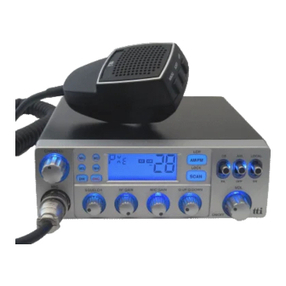
TTI
TTI Freequency TCB-880 User manual

TTI
TTI TCB-560 User manual
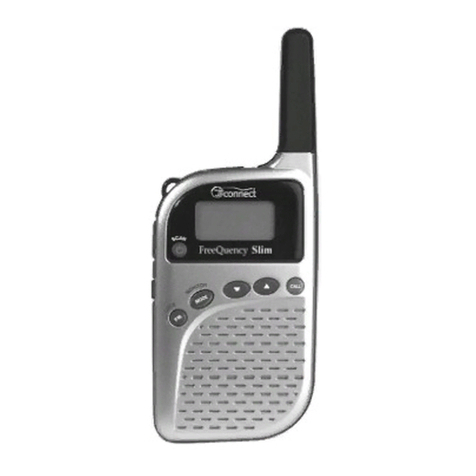
TTI
TTI Freequency PMR-500TX User manual
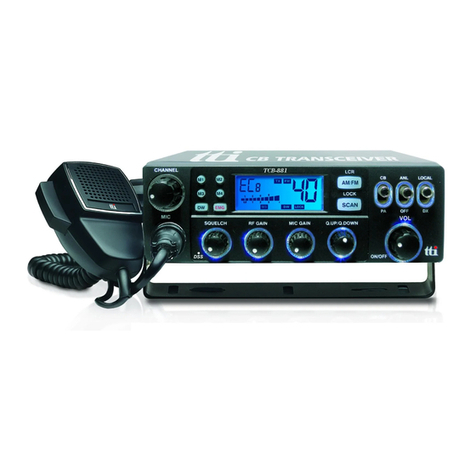
TTI
TTI TCB-881 User manual
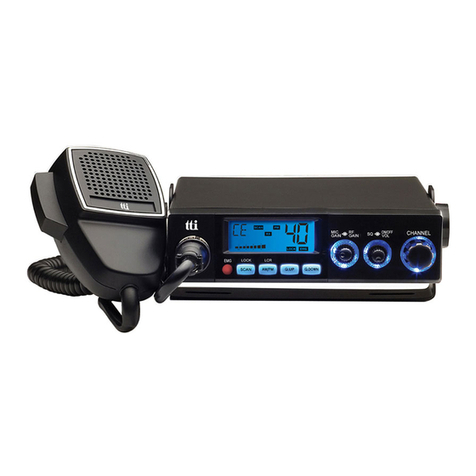
TTI
TTI Freequency TCB-770 User manual
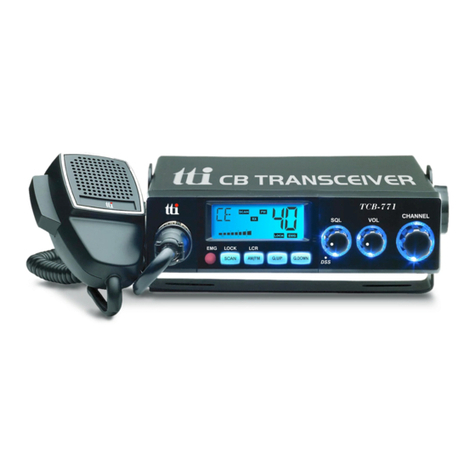
TTI
TTI TCB-771 User manual

TTI
TTI Freequency TCB-770 User manual

TTI
TTI TCB-771 User manual
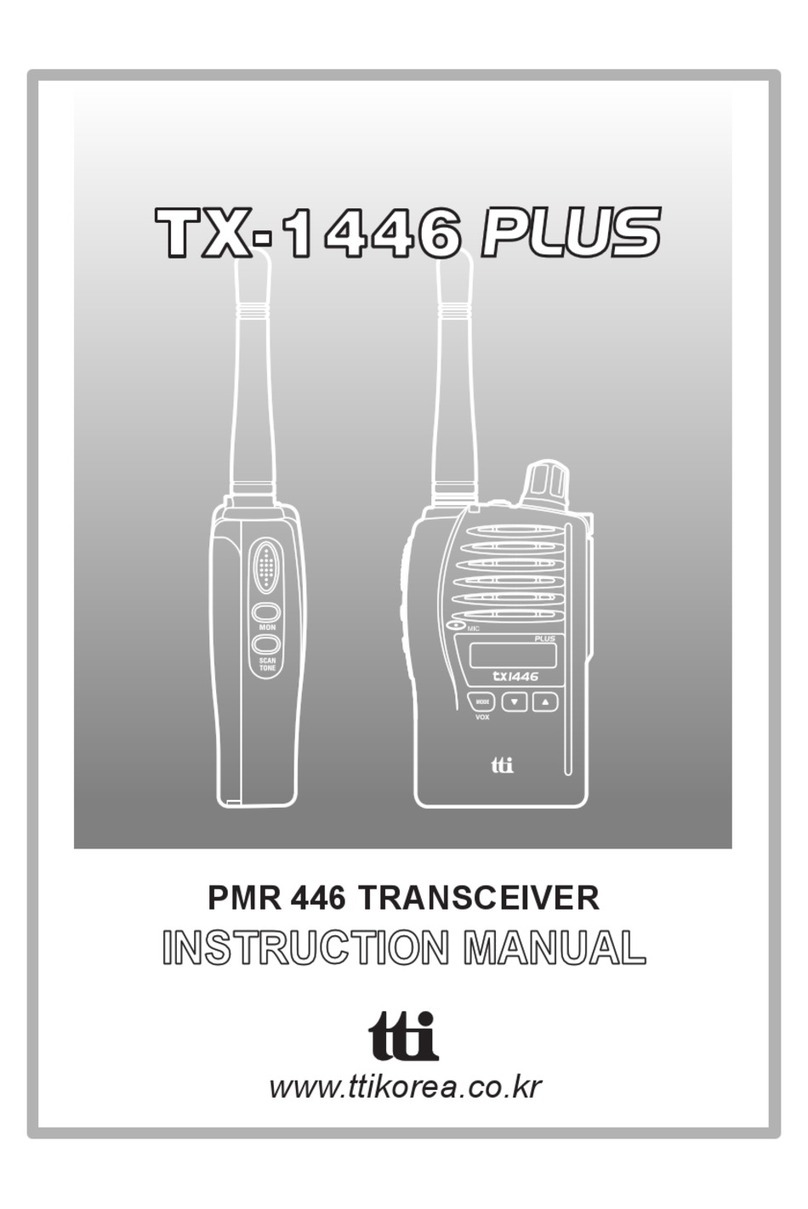
TTI
TTI TX-1446 Plus User manual

TTI
TTI TCB-1100 User manual
